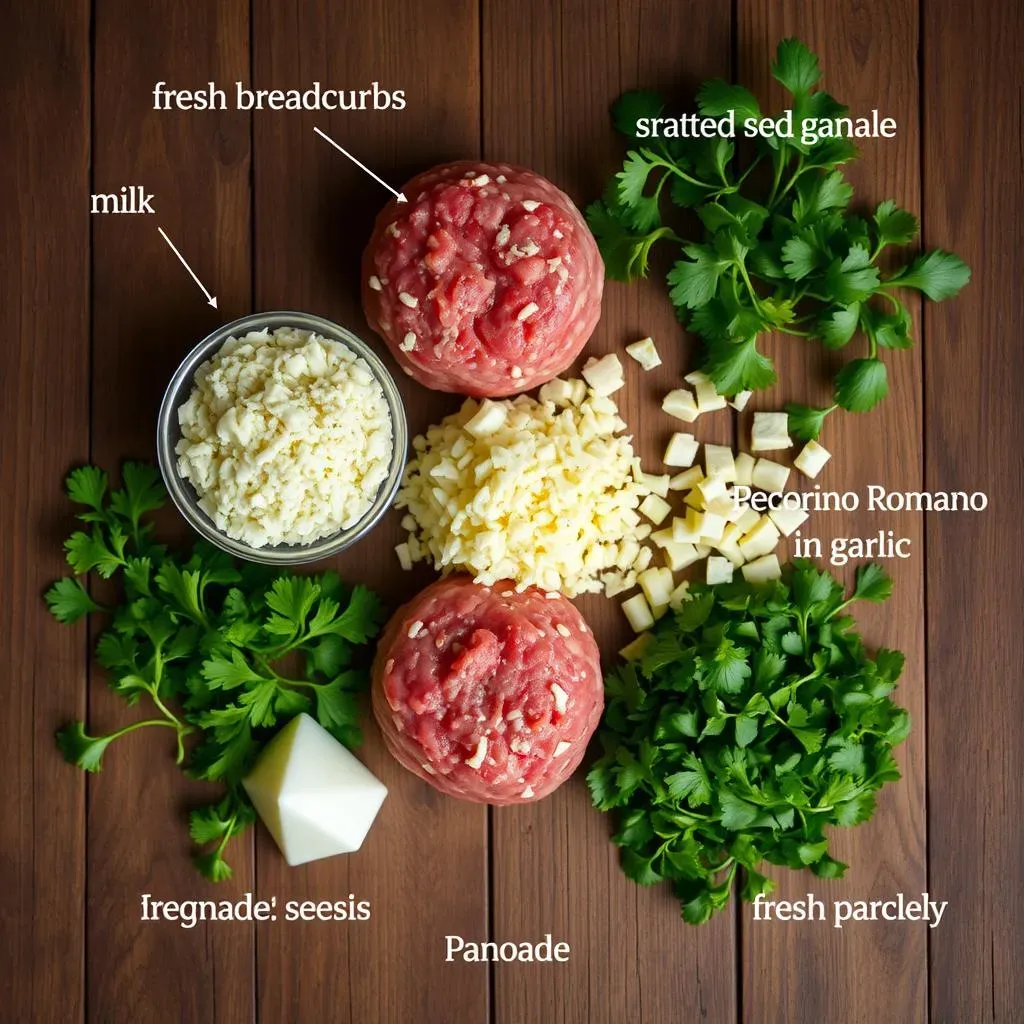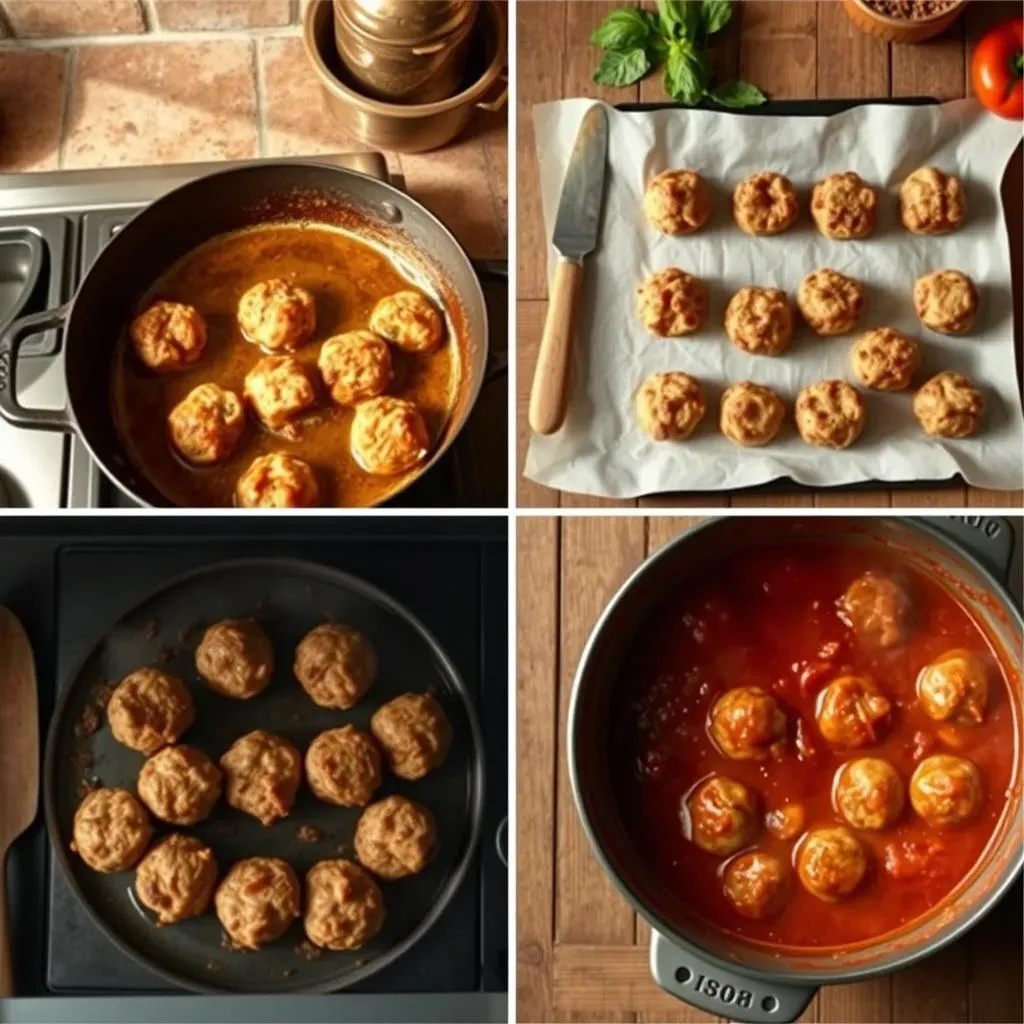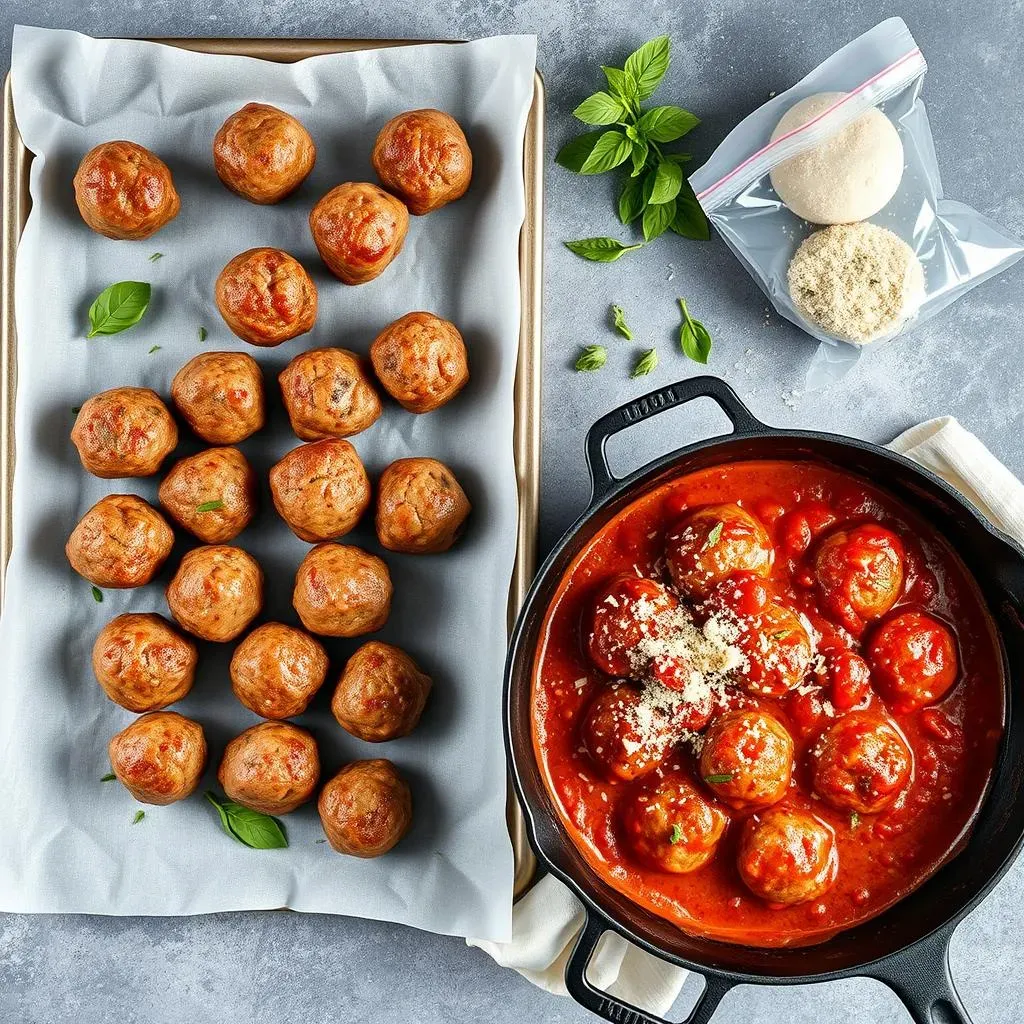Table of Contents
Who doesn't love a plate of classic Italian meatballs? This isn't just any recipe; it's a journey into creating the most tender, juicy, and flavorful Italian-American style meatballs you've ever tasted. This recipe italian meatballs is based on family tradition, passed down through generations, with a few tweaks to ensure perfection every time. Forget dry, tough meatballs – we're talking melt-in-your-mouth deliciousness that will have everyone asking for seconds.
The Best Meat for Italian Meatballs: A Guide

The Best Meat for Italian Meatballs: A Guide
Ground Beef: The Heart of the Meatball
When it comes to Italian meatballs, ground beef is your workhorse. But not just any ground beef will do. You're aiming for flavor and a bit of fat to keep things juicy. Ground chuck, with its 80/20 lean-to-fat ratio, is generally considered the sweet spot. It's got enough fat to prevent dryness, but not so much that your meatballs shrink into sad, greasy little nuggets. Using a leaner ground beef, like ground sirloin, can work, but you'll need to compensate with extra moisture – think more breadcrumbs soaked in milk or a drizzle of olive oil.
Ground Pork: Adding Depth and Richness
Ground pork brings a depth of flavor that beef simply can't match. It adds a subtle sweetness and richness that elevates your meatballs from good to unforgettable. A blend of ground beef and ground pork is a classic combination for a reason. The pork contributes a certain unctuousness that keeps the meatballs moist and tender. Look for ground pork that isn't too lean – you want some of that fat for flavor and texture. If you're feeling adventurous, you could even experiment with different types of ground pork, like a coarser ground variety, for a more rustic texture.
Veal: The Optional Luxury
Veal is the wildcard in the meatball game. It's not essential, but it adds a certain delicate tenderness and refined flavor that's hard to resist. If you're looking to take your meatballs to the next level, consider adding ground veal to the mix. It blends beautifully with beef and pork, creating a truly exceptional meatball. However, veal can be more expensive and harder to find than beef or pork. If you can't get your hands on it, don't sweat it – your meatballs will still be amazing with just beef and pork. But if you're feeling fancy, give veal a try. You might just discover your new favorite meatball ingredient.
Meat Type | Flavor Profile | Texture Contribution |
|---|---|---|
Ground Beef (Chuck) | Savory, Beefy | Provides structure and heartiness |
Ground Pork | Rich, Slightly Sweet | Adds moisture and depth of flavor |
Ground Veal | Delicate, Mild | Enhances tenderness and refinement |
Ingredients Spotlight: Elevate Your Italian Meatballs Recipe

Ingredients Spotlight: Elevate Your Italian Meatballs Recipe
Breadcrumbs: The Key to Tenderness
Let's talk breadcrumbs. Forget the dry, dusty stuff in a can. The secret to truly tender Italian meatballs is using fresh breadcrumbs soaked in milk – what the Italians call a "panade." This mixture of bread and milk acts as a binder, holding moisture and preventing the meatballs from becoming dense and tough. Tear up some crusty Italian bread, soak it in milk until it's completely saturated, and then squeeze out the excess liquid. This milky bread mixture will work wonders for your meatball texture. If you only have dried breadcrumbs on hand, you can use them, but be sure to soak them in milk or water for at least 15 minutes before adding them to the meat mixture. Panko breadcrumbs can also be used, but they'll result in a slightly coarser texture. Gluten-free breadcrumbs are a fine substitute for those with dietary restrictions. Just be mindful of the salt content, as some gluten-free breadcrumbs can be quite salty, and adjust accordingly.
Cheese: Adding Flavor and Umami
Cheese is non-negotiable when it comes to Italian meatballs. Freshly grated Pecorino Romano or Parmesan cheese adds a salty, savory, and umami-rich flavor that elevates the meatballs to a whole new level. I always recommend grating your cheese fresh, as pre-grated cheese often contains cellulose, which can prevent it from melting properly and integrating into the meat mixture. Pecorino Romano is a sheep's milk cheese that's saltier and sharper than Parmesan, while Parmesan is a cow's milk cheese that's nuttier and milder. You can use either cheese, or even a blend of both, depending on your preference. Just be sure to use a good quality cheese for the best flavor. Avoid using pre-shredded mozzarella or other melting cheeses, as they won't provide the same depth of flavor and can make the meatballs greasy.
Garlic and Herbs: Infusing Aroma and Freshness
Garlic and fresh herbs are the aromatic backbone of Italian meatballs. Freshly minced garlic adds a pungent, savory flavor that complements the meat and cheese perfectly. Don't be shy with the garlic – I usually use at least 2-3 cloves per pound of meat. Fresh parsley or basil adds a bright, herbaceous note that balances the richness of the meat and cheese. Chop the herbs finely and add them to the meat mixture along with the garlic. You can also add other herbs, such as oregano, thyme, or rosemary, depending on your preference. Dried herbs can be used in a pinch, but they won't provide the same fresh flavor as fresh herbs. If using dried herbs, reduce the amount by half, as dried herbs are more concentrated in flavor than fresh herbs.
Ingredient | Flavor Contribution | Tips for Use |
|---|---|---|
Fresh Breadcrumbs (Panade) | Moisture, Tenderness | Soak in milk, squeeze out excess liquid |
Pecorino Romano or Parmesan | Salty, Savory, Umami | Grate fresh, use good quality cheese |
Fresh Garlic | Pungent, Savory | Mince finely, don't be shy |
Fresh Parsley or Basil | Bright, Herbaceous | Chop finely, use generously |
StepbyStep: How to Make Tender Italian Meatballs

StepbyStep: How to Make Tender Italian Meatballs
Mixing the Ingredients: A Gentle Approach
Alright, let's get our hands dirty! But remember, the key to tender meatballs is a gentle touch. Overmixing is the enemy, as it develops the gluten in the breadcrumbs and makes the meatballs tough. In a large bowl, combine your ground beef, ground pork (and veal, if you're using it), soaked breadcrumbs, grated cheese, minced garlic, chopped herbs, eggs, salt, and pepper. Use your hands to gently mix everything together until just combined. Don't be afraid to get in there and squish things around, but be mindful not to overwork the mixture. If the mixture seems too dry, add a splash of milk or olive oil to moisten it. If it seems too wet, add a bit more breadcrumbs. The goal is to create a mixture that's cohesive but still light and airy.
Forming the Meatballs: Size Matters
Now comes the fun part: forming the meatballs! The size of your meatballs is up to you, but I generally aim for about 1.5 to 2 inches in diameter – about the size of a golf ball. Using a cookie scoop or your hands, portion out the meat mixture and gently roll it into a round shape. Again, be gentle! Avoid packing the meat too tightly, as this will result in dense meatballs. Place the formed meatballs on a baking sheet lined with parchment paper. This will prevent them from sticking and make cleanup a breeze. If you're planning to cook the meatballs right away, you can leave them at room temperature while you preheat your oven or prepare your stovetop. If you're not cooking them right away, you can refrigerate them for up to 24 hours.
Seasoning and Resting: The Flavor Boost
Before cooking, give your meatballs a final flavor boost with a generous sprinkle of salt and pepper. This will help to enhance the flavors and create a delicious crust when the meatballs are browned. Let the formed meatballs rest for at least 15 minutes before cooking. This allows the flavors to meld together and the meatballs to firm up slightly, which will prevent them from falling apart during cooking. While the meatballs are resting, you can prepare your tomato sauce or preheat your oven. Once the meatballs have rested, they're ready to be cooked using your preferred method – stovetop, baking, or simmering in sauce. Remember, the key to perfect meatballs is patience and attention to detail. Follow these steps, and you'll be well on your way to creating the most tender, juicy, and flavorful Italian meatballs you've ever tasted!
Step | Description | Tips |
|---|---|---|
Mixing | Combine ingredients gently | Avoid overmixing to prevent toughness |
Forming | Shape into 1.5-2 inch balls | Don't pack too tightly |
Seasoning | Sprinkle with salt and pepper | Enhances flavor and crust |
Resting | Let rest for 15 minutes | Allows flavors to meld and meatballs to firm up |
Cooking Italian Meatballs: Stovetop, Baking, and Finishing in Sauce

Cooking Italian Meatballs: Stovetop, Baking, and Finishing in Sauce
Alright, you've got your beautifully formed Italian meatballs, now it's time to cook them! You have a few options here, each with its own advantages. We can tackle the stovetop method, baking, or finishing them right in the sauce. Each method brings a unique texture and flavor, so let's break them down. Whether you're after that crispy exterior from stovetop searing, the even cooking of the oven, or the deep flavor infusion from simmering in sauce, I’ll guide you through each technique. You can choose what best suits your preference and time.
Stovetop Searing: Building Flavor and Texture
The stovetop method is all about building flavor through browning. Heat some olive oil in a large skillet over medium-high heat. Once the oil is shimmering, add the meatballs in a single layer, being careful not to overcrowd the pan. Sear the meatballs on all sides until they're nicely browned and crusty. This browning process, known as the Maillard reaction, creates hundreds of flavor compounds that add depth and complexity to the meatballs. Once the meatballs are browned, you can either finish cooking them in the skillet by reducing the heat and covering the pan, or transfer them to your favorite tomato sauce to simmer until cooked through. The stovetop method is great for achieving a crispy exterior and a rich, caramelized flavor.
Baking: Hands-Off and Even Cooking
Baking is a more hands-off approach that's perfect for when you're cooking a large batch of meatballs. Preheat your oven to 425°F (220°C). Place the formed meatballs on a baking sheet lined with parchment paper. Bake for 15-20 minutes, or until the meatballs are cooked through and lightly browned. Baking provides even cooking and eliminates the need to constantly turn the meatballs, as you would on the stovetop. While the meatballs won't get as crusty as they would with the stovetop method, they'll still develop a delicious flavor and tender texture. Baking is a great option for busy weeknights when you want to get dinner on the table quickly and easily.
Cooking Method | Pros | Cons |
|---|---|---|
Stovetop Searing | Crispy exterior, rich flavor | Requires more attention, can be uneven if overcrowded |
Baking | Hands-off, even cooking | Less crispy than stovetop |
Finishing in Sauce: Flavor Infusion and Tenderness
Finishing the meatballs in sauce is a classic Italian technique that allows the meatballs to absorb the flavors of the sauce and become incredibly tender. After browning the meatballs on the stovetop or baking them in the oven, transfer them to your favorite tomato sauce. Bring the sauce to a simmer, then reduce the heat to low, cover, and simmer for at least 30 minutes, or up to a few hours. The longer the meatballs simmer in the sauce, the more flavorful and tender they'll become. This method is perfect for making a big batch of meatballs on a Sunday afternoon and enjoying them throughout the week. The sauce not only infuses the meatballs with flavor but also helps to keep them moist and prevents them from drying out.
Step | Description | Tips |
|---|---|---|
Stovetop | Sear meatballs in oil until browned | Don't overcrowd the pan |
Baking | Bake at 425°F (220°C) for 15-20 minutes | Line baking sheet with parchment paper |
In Sauce | Simmer browned/baked meatballs in sauce | Simmer for at least 30 minutes for flavor infusion |
Freezing Italian Meatballs: A Simple Guide

Freezing Italian Meatballs: A Simple Guide
So, you've made a big batch of these amazing Italian meatballs, and you're wondering if you can freeze them for later? Absolutely! Freezing Italian meatballs is a fantastic way to meal prep and have a delicious, home-cooked meal ready whenever you need it. Whether they're cooked or uncooked, these little guys freeze beautifully, making them perfect for busy weeknights or unexpected guests. The key is to do it right to maintain their flavor and texture. Let's dive into the simple steps for freezing these flavor bombs, so you can enjoy them whenever the craving strikes!
Freezing Uncooked Meatballs: The Raw Deal
Freezing uncooked meatballs is super easy, and it's a great way to preserve them without any cooking beforehand. First, arrange the uncooked meatballs in a single layer on a baking sheet lined with parchment paper. Make sure they aren't touching each other, or they'll freeze together in one big clump. Place the baking sheet in the freezer for about 2-3 hours, or until the meatballs are frozen solid. Once they're frozen, transfer them to a freezer-safe bag or container. This two-step process prevents them from sticking together and makes it easy to grab just a few meatballs at a time. When you're ready to cook them, you can cook them directly from frozen, adding a few extra minutes to the cooking time.
Freezing Cooked Meatballs: Lock in the Flavor
Freezing cooked meatballs is just as simple. Allow the cooked meatballs to cool completely before freezing. This prevents condensation from forming, which can lead to freezer burn and affect the texture of the meatballs. Once they're cooled, arrange them in a single layer on a baking sheet lined with parchment paper and freeze for about 2-3 hours, or until solid. Transfer the frozen meatballs to a freezer-safe bag or container. When you're ready to use them, you can reheat them in the microwave, oven, or simmer them in your favorite tomato sauce. Freezing cooked meatballs is a great way to have a quick and easy meal ready in minutes.
Packaging and Storage: Keeping it Fresh
Proper packaging is essential for preventing freezer burn and maintaining the quality of your frozen meatballs. Use freezer-safe bags or containers that are airtight. Remove as much air as possible from the bag or container before sealing. This will help to prevent freezer burn. Label the bag or container with the date and contents so you know when you froze them and what's inside. Frozen meatballs can be stored in the freezer for up to 3 months. After 3 months, the quality may start to decline, but they'll still be safe to eat. For best results, use them within 3 months.
Freezing Method | Steps | Tips |
|---|---|---|
Uncooked | Freeze on baking sheet, then transfer to bag | Prevents sticking, cook from frozen |
Cooked | Cool completely, freeze on baking sheet, then transfer to bag | Prevents condensation, reheat in microwave, oven, or sauce |
Thawing and Reheating: From Freezer to Feast
When you're ready to enjoy your frozen meatballs, you have a few options for thawing and reheating. You can thaw them in the refrigerator overnight, which is the safest and most recommended method. You can also thaw them in the microwave, but be careful not to overcook them. If you're short on time, you can cook them directly from frozen, adding a few extra minutes to the cooking time. To reheat cooked meatballs, you can microwave them, bake them in the oven, or simmer them in your favorite tomato sauce. Simmering them in sauce is a great way to rehydrate them and add extra flavor. No matter which method you choose, make sure the meatballs are heated through before serving. Enjoy your delicious, homemade Italian meatballs!
Method | Description | Tips |
|---|---|---|
Refrigerator | Thaw overnight | Safest method |
Microwave | Thaw on low power | Watch carefully to avoid overcooking |
Directly in Sauce | Simmer in sauce until heated through | Adds flavor and moisture |
Your Perfect Italian Meatballs Await
So, there you have it – everything you need to create truly exceptional Italian meatballs. From selecting the right meat and mastering the panade to choosing your preferred cooking method and storing leftovers, you're now armed with the knowledge to impress family and friends. Don't be afraid to experiment with the recipe, adding your own personal touch to make it a signature dish. Now, get cooking and enjoy the delicious results!